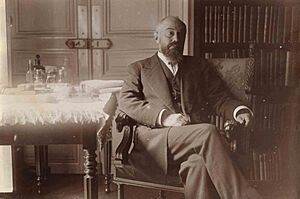Pierre Janet facts for kids
Quick facts for kids
Pierre Janet
|
|
|---|---|
 |
|
| Born |
Pierre Marie Félix Janet
30 May 1859 Paris, France
|
| Died | 24 February 1947 (aged 87) Paris, France
|
| Nationality | French |
| Scientific career | |
| Fields | Psychology, philosophy, psychiatry |
| Influenced | Alfred Adler, Sigmund Freud, William James, Carl Jung |
Pierre Janet (born May 30, 1859 – died February 24, 1947) was a very important French psychologist. He was also a doctor, philosopher, and psychotherapist. He made big discoveries about how our minds can separate memories, especially after a difficult experience. This is called dissociation.
Many people see him as one of the main founders of modern psychology, along with William James and Wilhelm Wundt. He was one of the first to suggest that things that happened in the past can affect how we feel and act today. He also studied sleepwalking that was brought on by suggestion.
Contents
Life Story
Pierre Janet studied in Paris at the Pitié-Salpêtrière Hospital. His teacher was a famous doctor named Jean-Martin Charcot.
Janet first shared his research findings in 1889. He wrote about them in his philosophy paper and then in his medical paper in 1892. This paper was about the mental state of people with hysteria, a term used back then for certain mental health conditions.
In 1898, Janet became a psychology teacher at the Sorbonne. In 1901, he started the French Psychological Society. A year later, he became a professor at the Collège de France, where he taught until 1936. He was a key figure in French psychology for many years.
Janet's Ideas About the Mind
Janet was one of the first to say that past events can cause problems in the present. He also created the words "dissociation" and "subconscious". Dissociation is when parts of your mind or memory feel separated from each other. The subconscious refers to thoughts or feelings that are in your mind but you're not fully aware of them.
He also studied how patients and hypnotists connected. This idea was similar to what later became known as transference in therapy.
In the 1900s, Janet developed a big idea about how the mind works. He thought about it in terms of energy levels and how well people could handle social situations. He wrote about these ideas in books like Obsessions and Psychasthenia (1903).
How Our Minds Develop
Janet believed our minds develop through different levels, like steps on a ladder. He described nine "tendencies" or ways our minds work, from simple actions to complex thinking.
He explained that there are:
- Four "lower tendencies" for basic actions and simple thoughts.
- Two "middle tendencies" for language and social interactions.
- Three "higher tendencies" for work, experiments, and new ideas.
Janet thought that some mental health issues, like neurosis, could happen if parts of the mind didn't connect well or if someone went back to earlier ways of thinking. He also said that the subconscious is like a hidden part of our mind. He believed it was the cause of many symptoms in people with hysteria. He called this hidden part the second state of personality.
How Janet Influenced Other Thinkers
William James
William James, a famous American psychologist, was very interested in Janet's work. In 1890, James wrote about Janet's observations of patients who seemed to have "hidden selves" or multiple personalities. These patients sometimes went into trances or subconscious states. James wondered how much our minds could split into separate parts.
Sigmund Freud
There was some debate about whose ideas came first, Janet's or Sigmund Freud's. Before 1913, Freud often said that Janet's ideas were helpful to his own work. He mentioned that he and his colleague, Josef Breuer, followed Janet's lead by focusing on the "splitting of the mind" and "dissociation."
However, in 1913, Janet suggested that many of Freud's new terms were just old ideas with new names. This made Freud's followers angry, and Freud's opinion of Janet changed. Freud later felt that Janet had unfairly taken credit away from him.
Most experts today agree that Janet's published ideas were a starting point for Freud. But Freud then developed these ideas much further in his own unique way.
Carl Jung
Carl Jung, another very important psychologist, studied with Janet in Paris in 1902. Janet's ideas greatly influenced him. For example, Jung's idea of a "complex" (a group of unconscious feelings or ideas) was similar to Janet's "fixed subconscious idea."
Jung also saw the mind as having many "fragmentary personalities," which built on Janet's idea of "simultaneous psychological existences." Jung often spoke highly of Janet's work in understanding mental health symptoms and exploring the unconscious mind.
Alfred Adler
Alfred Adler openly said that his idea of the "inferiority complex" came from Janet's concept of "feelings of incompleteness." Both men mentioned each other's work on this topic in their writings.
See also
 In Spanish: Pierre Janet para niños
In Spanish: Pierre Janet para niños
- Alfred Binet
- Henri Bergson
- Henri Ey
- Henri Piéron
- Jean Piaget
- Josiah Royce
- Loevinger's stages of ego development


